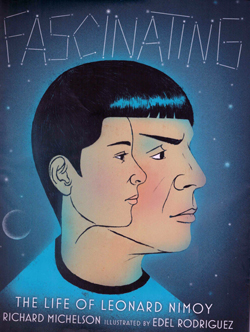Fascinating: The Life of Leonard Nimoy by Richard Michelson, illustrated by Edel Rodriguez; Alfred E. Knopf publisher; ISBN 9781101-933329; 28 pages, including author’s note, $17.99.

 SAN DIEGO – With all the ongoing celebrations of Star Trek’s 50th anniversary, the youngsters in your life may be wondering what all the hoopla is about. This short well-illustrated book will acquaint them with Leonard Nimoy, the actor who played the beloved Spock, a half-human, half-Vulcan who served as the science officer on the Starship Enterprise.
SAN DIEGO – With all the ongoing celebrations of Star Trek’s 50th anniversary, the youngsters in your life may be wondering what all the hoopla is about. This short well-illustrated book will acquaint them with Leonard Nimoy, the actor who played the beloved Spock, a half-human, half-Vulcan who served as the science officer on the Starship Enterprise.
In addition to being an actor, Nimoy was a fine photographer and he developed a close relationship with Michelson, his gallerist. Inspired to write a book about his friend, and icon, Michelson reports that he sent off his draft to Nimoy shortly before the actor’s death and received an email back praising the work and urging him to go forward.
The book relates that Nimoy’s parents were Jewish immigrants from Russia and they along with Nimoy’s grandparents and siblings lived in a Boston tenement. Money was always an issue in their lives and Nimoy worked at a variety of jobs as a boy, among them selling newspapers on street corners.
But Nimoy’s love was performing both as a singer and an actor, the latter helped along by a scholarship to Boston College’s summer acting workshop, given to him by a friendly neighborhood priest.
Eventually, Nimoy made his way to Hollywood; his father’s cautionary words ringing in his ears. Actors starve, his father had said. If Nimoy would learn to play the accordion at least he could earn a living.
Trying out for every part that he could, he supported himself in the meantime with numerous jobs, including driving a taxicab in Los Angeles. On one occasion a young man with a Boston accent rode in his cab and Nimoy told him he was getting discouraged and thinking of going home to Boston. The man counseled him to not give up as long as he could make a difference in people’s lives. Then he gave Nimoy his card: “Congressman John F. Kennedy,” it said. Like Nimoy, the future president of the United States would become an iconic figure of the 1960s.
Nimoy’s big break came when producer Gene Roddenberry offered him the role of Spock, who having been raised on Vulcan, but having a human mother, was always conducting an internal war with himself. Vulcans were logical, humans emotional. He favored his father’s ways, but sometimes when he least expected it, and although he would fight it, his emotions could take over. Spock had tremendous curiosity; he viewed as “fascinating” not only the scientific anomalies he encountered in space, but also the human interactions he witnessed aboard the Enterprise.
In season two of the series, Spock returned to his Vulcan world for a visit. He decided that Vulcans should greet other differently than humans do, and reaching back into his experience as a boy seeing the leaders of his congregation deliver the priestly blessing, he introduced the world to the split-fingered hand gesture used by kohanim for such occasions. “Live Long and Prosper!” a writer had him say, and the gesture and phrase became his trademarks.
Although the network canceled the show, fans remained loyal to Star Trek which forecast a time when all humanity would live and work together in peace. Subsequently, there were Star Trek conventions, lectures, and eventually Hollywood decided to cash in on the phenomenon. New Star Trek series made their way onto television, along with Star Trek movies, some featuring the original cast including Nimoy and actor William Shatner, who played Captain Kirk.
Nimoy’s character, being half-Vulcan, outlived many of his human contemporaries and appeared in shows that were scripted to occur many years beyond the human life span.
The actor’s story is well told with illustrations that amplify upon Nimoy’s biography and character.
*
Harrison is editor of San Diego Jewish World. He may be contacted via donald.harrison@sdjewishworld.com. Comments intended for publication in the space below MUST be accompanied by the letter writer’s first and last name and by his/ her city and state of residence (city and country for those outside the United States.)